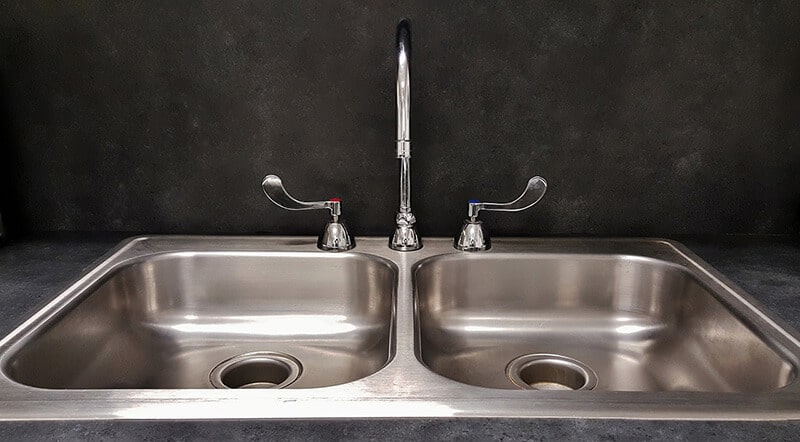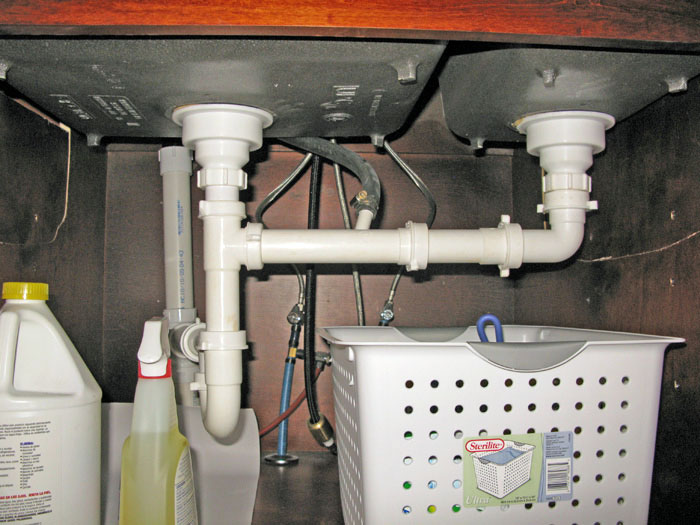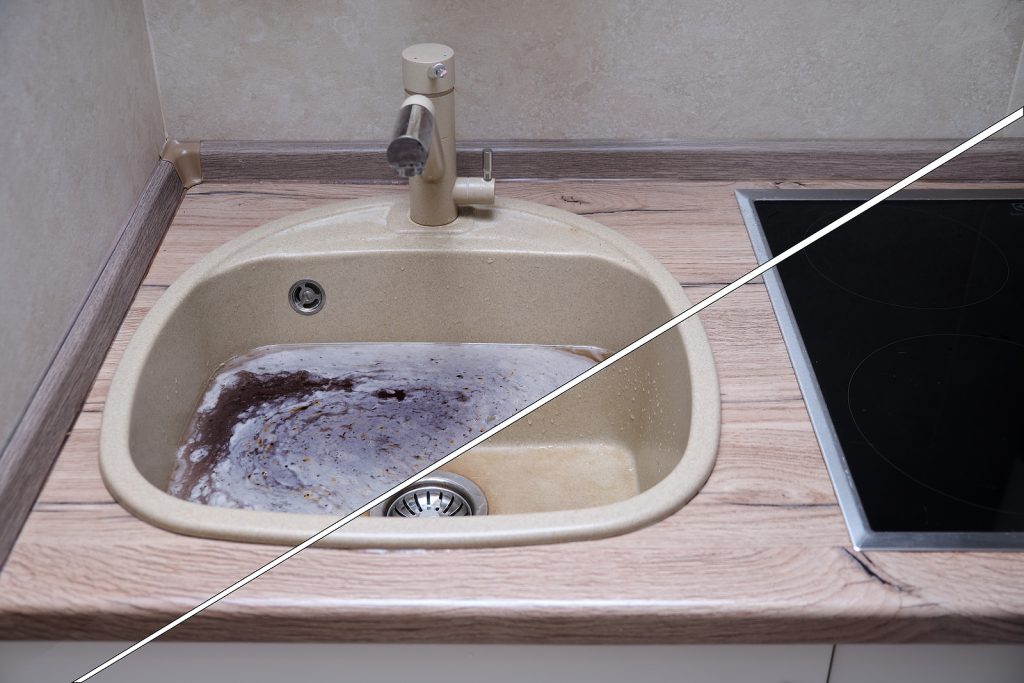If your kitchen sink faucet is making a loud, rhythmic pumping noise, it can be quite annoying and disruptive to your daily routine. Not to mention, it can also be a sign of a deeper issue with your plumbing system. But don't worry, there are some simple steps you can take to fix the problem and get your kitchen sink back to its quiet, peaceful state. First, check the water supply valves under your sink and make sure they are fully open. Sometimes, a partially closed valve can cause the water to flow unevenly, resulting in a pumping noise. If the valves are fully open and the noise persists, the problem may be with the faucet itself. Next, try cleaning the aerator on your faucet. Over time, debris and mineral deposits can build up in the aerator, causing water to flow unevenly and create noise. Simply unscrew the aerator and clean it with a mixture of water and vinegar. Then, rinse and reattach it to the faucet. If cleaning the aerator doesn't solve the issue, you may need to replace it entirely. A damaged or worn aerator can also cause a noisy faucet. You can find replacement aerators at most hardware stores.1. How to Fix a Noisy Kitchen Sink Faucet
If the noise is coming from the pipes underneath your sink, there are a few possible causes that you can troubleshoot. First, check to see if the pipes are securely fastened. Loose pipes can vibrate and create noise when water flows through them. If the pipes are securely fastened, the next step is to check the water pressure. High water pressure can cause pipes to vibrate and make noise. You can test the water pressure with a pressure gauge, which can be purchased at most hardware stores. If the pressure is too high, you may need to install a pressure-reducing valve. Another potential cause of noisy pipes is air in the system. Air can become trapped in the pipes, creating a pulsating noise when water flows through. To release the trapped air, turn off the water supply and open all the faucets in your home. Then, turn the water supply back on and slowly close the faucets one by one. This should release any trapped air and eliminate the noise.2. Troubleshooting a Rhythmic Pumping Noise in Your Kitchen Sink
If the above troubleshooting steps do not solve the problem, there may be a larger issue at hand. Some common causes of a rhythmic pumping noise in your kitchen sink include a faulty pressure regulator, a broken or damaged water pump, or a clogged drain line. The pressure regulator is responsible for maintaining a consistent water pressure in your home. If it is not functioning properly, it can cause water to flow unevenly and create noise. A broken or damaged water pump can also cause a pulsating noise, as it struggles to maintain water pressure. And a clogged drain line can cause water to back up and create noise as it tries to flow through the pipe.3. Common Causes of a Rhythmic Pumping Noise in Your Kitchen Sink
Once you have identified the source of the noise, you can take steps to quiet your kitchen sink. If the noise is coming from the faucet, make sure it is properly cleaned and the aerator is in good condition. If the noise is coming from the pipes, try securing them with additional clips or supports to prevent them from vibrating. If the issue is with the water pressure, you may need to install a pressure-reducing valve. And if the noise is caused by a clogged drain line, you can use a plumbing snake or call a professional plumber to unclog the line.4. How to Quiet a Noisy Kitchen Sink
Some DIY solutions for a noisy kitchen sink include installing a water hammer arrestor or adding foam insulation to the pipes. A water hammer arrestor is a device that absorbs the shock of water flow and can help reduce noise. Foam insulation can also help to muffle any vibrations in the pipes and reduce the noise. For a more permanent solution, you may need to replace your kitchen sink or upgrade your plumbing system. A new sink with a built-in sound-dampening material can significantly reduce noise. And upgrading your plumbing system to include water-saving features and high-quality pipes can also help prevent noisy pipes in the future.5. DIY Solutions for a Rhythmic Pumping Noise in Your Kitchen Sink
If you are unsure of the cause of the noise or are unable to fix it on your own, it may be best to call a professional plumber. They will be able to identify the source of the noise and provide a solution that is tailored to your specific plumbing system. It's important to address a noisy kitchen sink as soon as possible, as it can be a sign of a larger issue with your plumbing system. Ignoring the problem can lead to more significant and more costly repairs down the line.6. How to Identify and Fix a Rhythmic Pumping Noise in Your Kitchen Sink
To prevent a noisy kitchen sink in the future, there are a few simple steps you can take. Regularly clean and maintain your faucet and aerator to prevent debris from building up. Monitor your water pressure and make sure it is not too high. And be mindful of what you put down your drain to avoid clogs and backups. It's also a good idea to have your plumbing system inspected annually by a professional plumber. They can catch any potential issues before they become major problems and help keep your kitchen sink running smoothly and quietly.7. Tips for Preventing a Rhythmic Pumping Noise in Your Kitchen Sink
In addition to regular cleaning and maintenance, there are a few other ways to maintain your kitchen sink and prevent a noisy faucet or pipes. Avoid using harsh chemicals or drain cleaners, as they can damage your pipes and lead to clogs. Instead, use natural cleaning solutions or consult a professional plumber for safe and effective drain cleaning methods. You should also be mindful of what you put down your sink. Avoid disposing of grease, oils, and large food scraps, as they can cause clogs and backups in your drain line. And be sure to run hot water down your drain after each use to help prevent any buildup.8. How to Maintain Your Kitchen Sink to Avoid a Rhythmic Pumping Noise
If you are unable to fix the noise in your kitchen sink on your own, it's best to call a professional plumber for assistance. They have the knowledge, experience, and tools to identify and fix the issue quickly and effectively. Professional plumbing services can also help prevent future problems with your kitchen sink by providing regular maintenance and inspections. They can also offer advice on how to properly care for your plumbing system to avoid noisy pipes and faucets.9. Professional Plumbing Services for a Rhythmic Pumping Noise in Your Kitchen Sink
If your kitchen sink is old and outdated, it may be time for an upgrade. Newer sinks are designed with built-in sound-dampening materials and features that can help reduce noise. They are also more efficient and durable, making them a worthwhile investment for your home. When considering a new sink, look for one with a low decibel rating and features such as sound-absorbing pads and spray coatings. These will help to muffle the sound of running water and prevent any future noise issues in your kitchen sink. In conclusion, a noisy kitchen sink can be a frustrating and disruptive problem, but it's important to address it promptly to prevent any further damage to your plumbing system. By following these tips and seeking professional help when needed, you can enjoy a quiet and functional kitchen sink for years to come.10. Upgrading Your Kitchen Sink to Eliminate a Rhythmic Pumping Noise
The Rhythmic Pumping Noise of Kitchen Sink Water: A Design Element That Elevates Your Home

Creating a Harmonious Atmosphere in Your Home
 When it comes to designing a home, every detail matters. From the color of the walls to the type of flooring, each element contributes to the overall atmosphere and ambiance of a space. One often overlooked aspect of home design is the sound within a home. However, incorporating sound can add a whole new layer of depth to your home's design. One such element that can make a significant impact is the rhythmic pumping noise of kitchen sink water.
When it comes to designing a home, every detail matters. From the color of the walls to the type of flooring, each element contributes to the overall atmosphere and ambiance of a space. One often overlooked aspect of home design is the sound within a home. However, incorporating sound can add a whole new layer of depth to your home's design. One such element that can make a significant impact is the rhythmic pumping noise of kitchen sink water.
The Benefits of Adding Sound to Your Home Design
How to Incorporate the Rhythmic Pumping Noise of Kitchen Sink Water into Your Home
 One way to add this design element to your home is by installing a kitchen sink with a water pump. This type of sink uses a manual or electric pump to draw water from a separate container, creating the soothing sound of water flowing. Another option is to install a small water feature in your kitchen or bathroom, such as a fountain or a small waterfall, to add a constant and gentle sound of water.
One way to add this design element to your home is by installing a kitchen sink with a water pump. This type of sink uses a manual or electric pump to draw water from a separate container, creating the soothing sound of water flowing. Another option is to install a small water feature in your kitchen or bathroom, such as a fountain or a small waterfall, to add a constant and gentle sound of water.
The Final Touch to Your Home Design
:max_bytes(150000):strip_icc()/water-overflowing-in-kitchen-sink-200553937-001-5797e6335f9b58461f5a6736.jpg) Incorporating the rhythmic pumping noise of kitchen sink water into your home design is a unique and creative way to elevate the overall atmosphere of your space. Not only does it add a calming and harmonious element, but it also adds a touch of sophistication and elegance. So, the next time you're designing your home, don't forget about the power of sound.
Incorporating the rhythmic pumping noise of kitchen sink water into your home design is a unique and creative way to elevate the overall atmosphere of your space. Not only does it add a calming and harmonious element, but it also adds a touch of sophistication and elegance. So, the next time you're designing your home, don't forget about the power of sound.



























.jpg)





































:max_bytes(150000):strip_icc()/Basic-kitchen-sink-types-1821207_color_rev-0b539306b9ef4236a136624ad2a89a4c.jpg)


































